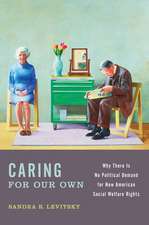Annual Review of Gerontology and Geriatrics, Volume 24, 2004: Intergenerational Relations Across Time and Place: Annual Review of Gerontology & Geriatrics, cartea 24
Autor Merril Silversteinen Limba Engleză Hardback – 31 oct 2004
This volume examines the importance of time and place, as applied to aging families. In the first section, chapters focus on the temporal dimension of intergenerational relations using frameworks from human development, sociology, social history, and social psychology. The second section focuses on the social ecology of intergenerational relations in terms of the national contexts within which families are embedded.
The contributors demonstrate how the social, cultural, historical, and institutional forces that orient older and younger family members toward each other in both structured and adaptive ways.
Din seria Annual Review of Gerontology & Geriatrics
- 11%
 Preț: 530.84 lei
Preț: 530.84 lei - 11%
 Preț: 532.74 lei
Preț: 532.74 lei - 5%
 Preț: 563.52 lei
Preț: 563.52 lei - 11%
 Preț: 527.94 lei
Preț: 527.94 lei - 11%
 Preț: 527.26 lei
Preț: 527.26 lei - 5%
 Preț: 566.48 lei
Preț: 566.48 lei - 5%
 Preț: 590.23 lei
Preț: 590.23 lei - 5%
 Preț: 862.94 lei
Preț: 862.94 lei - 14%
 Preț: 719.20 lei
Preț: 719.20 lei - 11%
 Preț: 535.83 lei
Preț: 535.83 lei - 11%
 Preț: 528.80 lei
Preț: 528.80 lei - 11%
 Preț: 528.47 lei
Preț: 528.47 lei - 11%
 Preț: 533.94 lei
Preț: 533.94 lei - 11%
 Preț: 536.36 lei
Preț: 536.36 lei - 11%
 Preț: 530.36 lei
Preț: 530.36 lei - 11%
 Preț: 530.50 lei
Preț: 530.50 lei - 5%
 Preț: 561.51 lei
Preț: 561.51 lei - 5%
 Preț: 563.16 lei
Preț: 563.16 lei - 11%
 Preț: 529.48 lei
Preț: 529.48 lei
Preț: 528.28 lei
Preț vechi: 593.57 lei
-11% Nou
101.09€ • 105.34$ • 83.70£
Carte disponibilă
Livrare economică 13-27 martie
Specificații
ISBN-10: 082611735X
Pagini: 320
Dimensiuni: 160 x 233 x 23 mm
Greutate: 0.56 kg
Ediția:New.
Editura: Springer
Seria Annual Review of Gerontology & Geriatrics
Textul de pe ultima copertă
This volume examines the importance of time and place, as applied to aging families. In the first section, chapters focus on the temporal dimension of intergenerational relations using frameworks from human development, sociology, social history, and social psychology. The second section focuses on the social ecology of intergenerational relations in terms of the national contexts within which families are embedded.
The contributors demonstrate how the social, cultural, historical, and institutional forces that orient older and younger family members toward each other in both structured and adaptive ways. "













